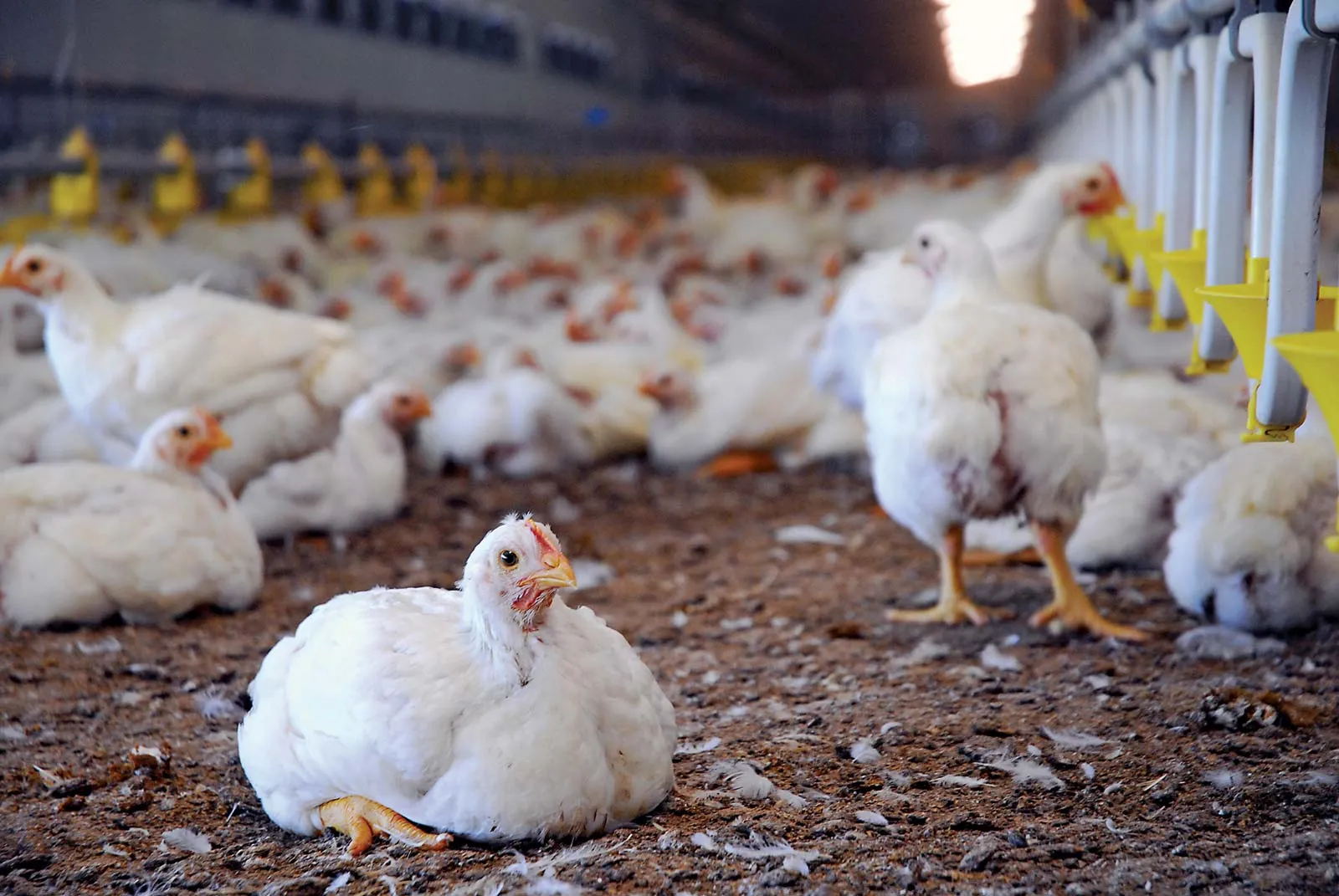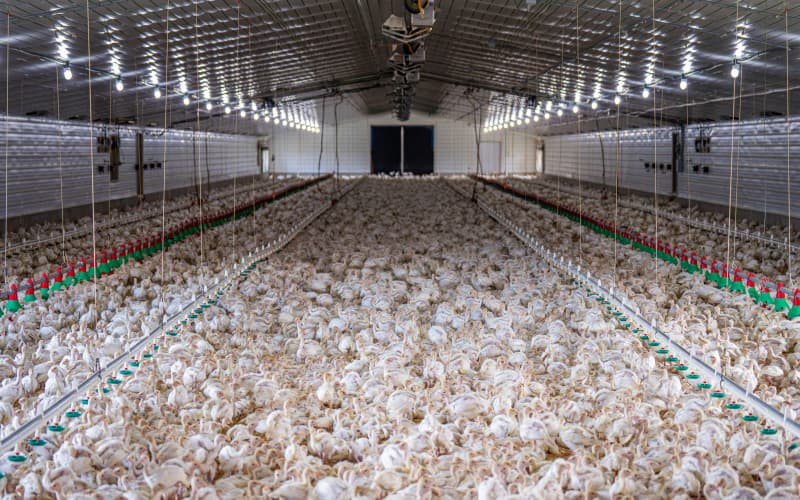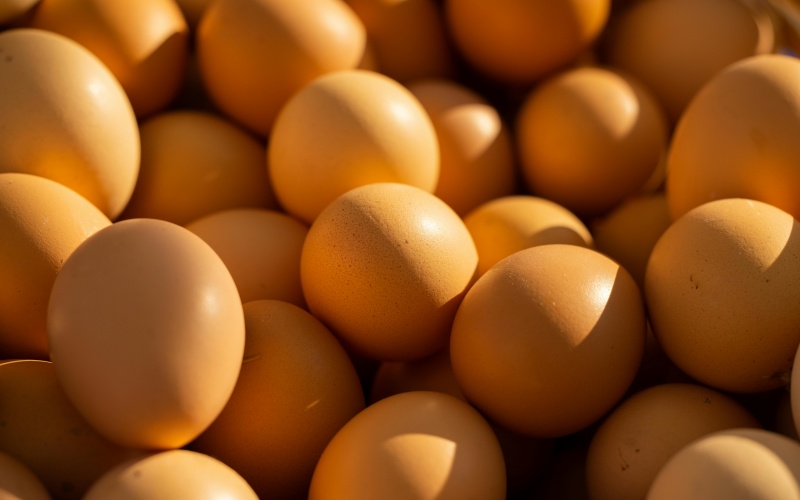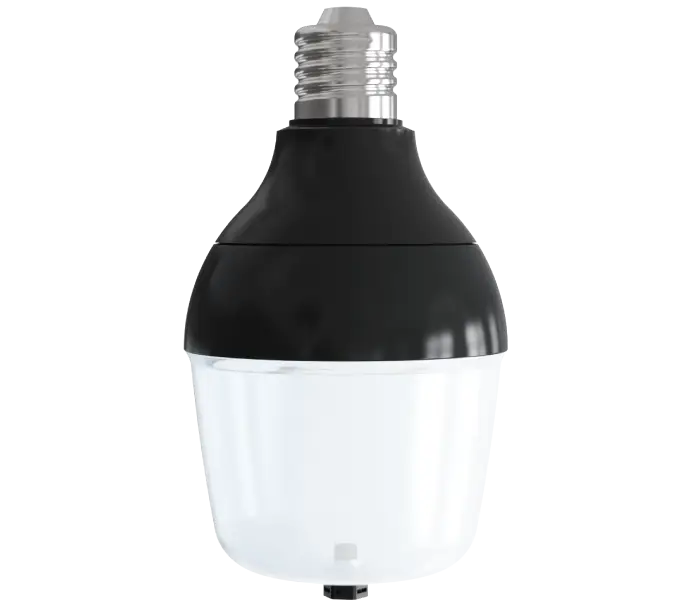Comment l'éclairage des élevages de volailles affecte-t-il la production et la croissance ?

Annuaire:
1. Pourquoi l'éclairage avicole est-il essentiel pour les fermes modernes ?
2. Explication des principaux paramètres de l'éclairage avicole
3. Des « lampes traditionnelles » à l’« éclairage intelligent »
4. Plans d'éclairage adaptés aux différents types de volailles
5. Problèmes courants liés à l'éclairage des élevages de volailles et solutions
6. Un avenir intelligent et écologique pour l'éclairage LED en élevage de volailles
7. Conclusion : L'éclairage avicole comme investissement à haut rendement
1. Pourquoi l'éclairage avicole est-il essentiel pour les fermes modernes ?
On croit souvent, à tort, que l'éclairage des élevages de volailles sert uniquement au confort du personnel. En réalité, cet éclairage a un impact direct sur la biologie des oiseaux .
Les poulets et autres volailles perçoivent un spectre lumineux plus large que les humains, incluant les ultraviolets, et leur croissance et leur reproduction sont étroitement liées aux signaux lumineux. La durée, l'intensité et le spectre de la lumière influencent la libération d'hormones via l'axe hypothalamo-hypophyso-gonadique, qui régule la production d'œufs, la croissance et la fertilité.
Dans les élevages avicoles fermés ou de grande taille, la lumière naturelle est soit irrégulière, soit totalement absente. Sans éclairage artificiel adéquat, la ponte des poules pondeuses peut diminuer, la croissance des poulets de chair peut être inégale et la fertilité des reproducteurs peut être compromise. Un éclairage efficace est donc indispensable : c’est un outil de gestion essentiel qui garantit une production accrue, un comportement stable du troupeau et une meilleure efficacité alimentaire.

2. Explication des principaux paramètres de l'éclairage avicole
L'éclairage LED d'une grange ne se résume pas à allumer et éteindre les lampes. Quatre facteurs techniques — la photopériode, l'intensité, le spectre et le rythme — interagissent pour influencer la croissance, le comportement et la productivité des volailles.
Nous les expliquons ci-dessous en termes simples, en soulignant les différents besoins des poules pondeuses , des poulets de chair et des reproducteurs .
2.1 Photopériode – « Combien de temps les lumières doivent-elles rester allumées ? »
La durée d'exposition quotidienne à la lumière influe directement sur la croissance et le cycle de reproduction des oiseaux. Les éleveurs doivent adapter les programmes en fonction de l'espèce et du stade de croissance.
(1) Poules pondeuses :
Phase de ponte : Les poules ont besoin de 14 à 16 heures de lumière continue (par exemple, 16 h de lumière : 8 h d’obscurité). Si la durée d’éclairage descend en dessous de 12 heures (comme en hiver), elles reçoivent un signal d’arrêt de ponte.
Élevage des poussins (0 à 6 semaines) : La durée d’éclairage est progressivement réduite de 24 heures à 8-10 heures. Ceci permet d’éviter que les poules n’atteignent leur maturité trop tôt.
(2) Poulets de chair :
Les animaux ont besoin de 18 à 22 heures de lumière tout au long de leur vie. Les longues journées allongent la durée des repas, ce qui entraîne une prise de poids. Cependant, au moins 2 à 4 heures d'obscurité sont essentielles pour le repos et la réduction du stress.
(3) Éleveurs :
Light schedules should mimic natural seasonal changes. Gradually lengthening daylength improves fertility and egg set rates.
Common mistake: Assuming “longer is always better.” For example, giving 20+ hours of light to layers actually stresses hens, reduces fertility, and lowers egg production.
2.2 Light Intensity – “How bright should it be?”
Light intensity is measured in Lux (1 Lux ≈ brightness of an overcast indoor room). Different stages and poultry types demand different levels:
(1) Brooding (0–2 weeks): 20–30 Lux. Bright light helps chicks find feed and water quickly, lowering early mortality.
(2) Laying hens (production stage): 10–20 Lux. If too strong (>30 Lux), hens become restless and develop harmful behaviors like feather pecking. Too dim (<5 Lux) reduces feed intake and egg yield.
(3) Broilers (fattening phase): 5–10 Lux. Lower brightness keeps birds calmer, reduces energy waste on movement, and supports rapid weight gain.
Practical tip: Light must be evenly distributed across the house. Avoid dark corners (<3 Lux) or hot spots. Adjust hanging height (2–3 m above ground) and lamp spacing (every 2–3 m) for balance.
2.3 Spectral Content – “Which colors matter most?”
In recent years, poultry lighting research has focused on spectrum optimization, challenging the old belief that “any white light will do.”
Traditional incandescent lamps lean toward warm light (red-dominant), while fluorescent lamps lean toward cool light (blue-dominant). However, both have limited spectral ranges and cannot precisely meet poultry needs.
In contrast, LED spectra can be customized, with each wavelength playing a different role:
l red light (620–660 nm) promotes egg production in layers and accelerates weight gain in broilers;
l blue light (450–495 nm) suppresses broiler activity but may cause stress;
l green light (520–560 nm) can help increase egg weight;
l UV-A (320–400 nm) supports vitamin D3 synthesis but requires careful control.
In practice, mixed light dominated by red wavelengths is recommended for layer houses, while broiler houses should prioritize warm red light with reduced blue content.
2.4 Light Rhythm – “Continuous or intermittent?”
Lighting schedules can be continuous or broken into cycles:
(1) Continuous lighting:
Example:
16 hours straight. Simple, but high energy consumption and greater bird fatigue.
(2) Intermittent lighting:
Example:
Layers: 2 hours light / 2 hours dark (repeating).
Broilers: 1 hour light / 3 hours dark (repeating).
Benefits of intermittent rhythm:
Saves 30–50% energy.
Gives birds more rest, lowering stress and aggression.
Research shows laying rates can improve slightly compared with continuous light.
Important note: Rhythms must remain consistent. Frequent changes disrupt circadian rhythm, stressing the flock.
In short:
When applied correctly, these parameters transform lighting from a utility into a powerful tool for poultry performance.
3. From “Traditional Lamps” to “Smart Lighting”
Lighting technology in poultry farming has changed dramatically over the past few decades. Each stage brought progress, but also limitations that explain why farms are now moving toward LED and smart systems.
Incandescent lamps were once the standard. Their spectrum is close to natural sunlight and the upfront cost is low. However, they waste most energy as heat, last only about 1,000 hours, and are unsuitable for modern large-scale houses. They remain practical only for small backyard or temporary setups.
Fluorescent lamps reduced energy use compared to incandescent and provided stronger brightness. Yet, they rely on fixed spectral output, contain mercury, and typically last around 8,000 hours. Many mid-sized farms adopted them during the transition era, but environmental concerns and limited spectral control restrict their value today.
LED lights have become the mainstream choice. They cut energy consumption by up to 70%, operate over 50,000 hours, and allow tailored spectral design for broilers, layers, or breeders. They are also mercury-free and environmentally friendly. While the initial cost is higher, the long-term performance and efficiency make LEDs the most cost-effective option for intensive poultry houses.
The latest step is smart LED systems. Beyond efficiency, they enable remote control via apps or central management software, automatic scheduling of photoperiods, and integration with climate sensors for temperature and humidity. These systems adjust lighting programs dynamically, ensuring optimal growth and reproduction with minimal manual intervention. Their upfront cost and need for professional setup are higher, but for modern farms aiming at precision management, smart lighting delivers unmatched benefits.

4. Tailored Lighting Plans for Different Poultry Types
Lighting strategies should never be “one size fits all.” Different poultry categories respond uniquely to light, so farmers must adapt programs for layers, broilers, and breeders.

(1) Laying hens (layers)
Photoperiod: 16 hours of light during production (e.g., 5:00–21:00) and 8 hours in the resting phase.
Intensity: 15 Lux evenly across the house; avoid shadowed corners below 10 Lux.
Spectrum: Red-to-blue ratio of 3:1 (around 660 nm red + 450 nm blue), with limited UV-A exposure (1–2 hours daily) to improve calcium absorption and shell strength.
Rhythm: Intermittent cycles (2 h light + 2 h dark) help conserve energy while reducing stress behaviors.
Know more details about Chicken Coop Lighting for Egg Production.
(2) Broilers (meat birds)
Photoperiod: 24 h light in the brooding phase (0–2 weeks), then 20 h light + 4 h dark from week 3 onward (e.g., 6:00–2:00).
Intensity: 25 Lux during brooding to encourage feeding and drinking; reduce to 8 Lux in the grow-out phase to limit activity and improve feed conversion.
Spectrum: Dominantly red (≈70% at 660 nm) with minimal blue (<10%) to minimize stress.
Rhythm: Continuous light early, then switch to intermittent cycles (1 h light + 3 h dark) to balance growth and rest.
(3) Breeders
Photoperiod: Seasonal simulation—gradually extend daylight hours from 12 to 16 as in spring.
Intensity: 15–20 Lux, strong enough to support activity but not excessive, which could disrupt mating.
Spectrum: Broad-spectrum lighting (red, green, blue) to mimic natural daylight and stimulate breeding behaviors.
Rhythm: Continuous light during the active phase to maintain consistent mating patterns.
When applied correctly, these tailored lighting programs improve performance, welfare, and efficiency across all poultry houses.
5. Common Problems in Poultry Lights and Solutions
Even with well-planned programs, lighting issues often appear in daily farm management. Below are the most frequent problems and actionable poultry lighting solutions.
Problem 1: Uneven light distribution
Cause: Lamps hung too high, wide spacing between fixtures, or insufficient lamp power.
Solution: Use a staggered hanging pattern instead of straight lines. Choose wide-angle LED lamps (≥120° beam angle). Add supplemental lights in corners to eliminate dark spots.
Problem 2: Sudden drop in egg production (excluding disease)
Possible causes: Shortened photoperiod due to timer failure, reduced light intensity from faulty lamps, or abrupt spectral changes after replacing bulbs.
Solution: Check timers and fixtures weekly. When replacing lights, phase in the new lamps over 1 week before a full switch. Keep photoperiod, intensity, and spectrum stable unless deliberately adjusted for growth stage.

Problem 3: Feather pecking or cannibalism in broilers
Causes: Excessive brightness (>10 Lux), too much blue light, or insufficient dark periods.
Solution: Reduce light intensity to 5–8 Lux. Shift spectrum toward red while reducing blue. Guarantee at least 4 continuous dark hours daily for rest.
Problem 4: High lighting costs
Solution: Upgrade to LED lamps to save up to 70% energy. Apply intermittent lighting cycles to reduce operating hours. Install smart controllers that adjust brightness automatically with daylight, lowering artificial light use during sunny hours.
6. Smart & Green Future of Poultry LED Lighting
The future of poultry lighting is moving beyond simple illumination. For large-scale farms, the next decade will be defined by smart integration and sustainable design.
6.1 Smart upgrades
Light–climate–feed integration: Smart systems will connect lighting with temperature, humidity, and feed intake data. For example, during heat stress, the system can automatically dim lights to reduce metabolic load.
Targeted lighting: With cameras and sensors, farms may provide individualized light programs. Weak or sick birds could receive longer photoperiods to encourage feeding, while the rest of the flock follows standard cycles.
Data-driven management: Systems will log photoperiods, intensity, and production metrics like egg count or weight gain. AI analysis will then suggest or automatically apply optimized lighting schedules tailored to each flock’s performance.
6.2 Green development
Energy efficiency: Research is pushing LED efficiency beyond 150 lumens per watt, cutting power costs further. Solar-assisted systems are likely to become viable for remote or off-grid farms.
Eco-friendly materials: Mercury-free, recyclable fixtures will become the industry standard, aligning with environmental regulations and farm sustainability goals.
Welfare-focused lighting: Welfare directives, especially in Europe, are driving adoption of sunrise–sunset simulation instead of abrupt on/off cycles. Such gradual transitions reduce stress and improve overall flock health.
As technology advances, poultry LED lighting will no longer be just about visibility—it will become a central tool for precision farming, sustainability, and animal welfare.
7. Conclusion: Poultry Lights as a High-Return Investment
For farmers, poultry lighting is not a background detail—it is a direct driver of production, welfare, and profitability. The right program can improve egg yield, shorten growth cycles, and reduce stress, while poor lighting undermines all of these.
Traditional lamps may seem affordable, but their high energy use, short lifespan, and limited control make them costly over time. By contrast, poultry LED lighting offers precise spectrum tuning, stable intensity, and smart automation that align with modern farm needs. It reduces electricity bills, lowers maintenance, and creates healthier conditions for layers, broilers, and breeders alike.
The path forward is clear: adopting poultry LED lighting is not just an upgrade—it is an investment in long-term performance, sustainability, and competitiveness. For farms aiming to maximize efficiency and prepare for future demands, switching to LED is the most practical and profitable decision today.
Related Product


8. FAQs
Q1: Which light is better for broilers?
A: La lumière blanche (LED à spectre complet) est optimale pour les poulets de chair. Elle améliore la consommation d'aliments, la croissance musculaire et la prise de poids de 8 à 10 % par rapport à la lumière rouge. La lumière blanche assure également un indice de conversion alimentaire constant (ICA de 1,6 contre 1,8 sous lumière rouge).
Q2 : Pourquoi la lumière rouge produit-elle des œufs plus petits ?
A : La lumière rouge peut déclencher prématurément la libération d'ocytocine, raccourcissant ainsi la durée de la formation du vitellus. Cela réduit le poids des œufs après 30 semaines. Pour compenser, il est conseillé d'ajouter de la lumière verte (5 lux) aux zones de nidification afin d'améliorer le métabolisme du calcium et la qualité de la coquille.
Q3 : La lumière rouge améliore-t-elle la production d’œufs chez les poules pondeuses ?
R : Oui, la lumière rouge (660 nm) accélère la maturation sexuelle et augmente le nombre d'œufs sur le long terme (18 à 60 semaines) en stimulant les hormones reproductives. Cependant, les œufs exposés à la lumière rouge sont systématiquement plus légers que ceux exposés à la lumière blanche ou verte, surtout après 30 semaines.
Pour la qualité des œufs, la lumière verte est supérieure à la lumière rouge, produisant des coquilles plus épaisses et plus résistantes.
Q4 : Comment la lumière rouge affecte-t-elle le comportement des poulets ?
A : La lumière rouge réduit le stress grâce à sa longueur d'onde plus longue (660 nm), ce qui perturbe très peu les rythmes circadiens. Elle favorise les comportements passifs (repos, lissage des plumes) et diminue l'agressivité au sein des groupes.
En revanche, la lumière bleue augmente l'anxiété chez les volailles (par exemple, halètement, regroupement chez les canards), tandis que la lumière blanche maintient la stabilité comportementale.
_thumb.jpg)
